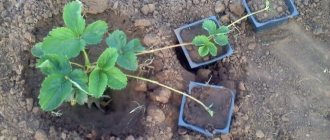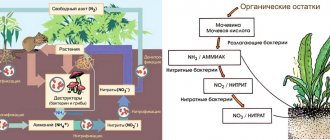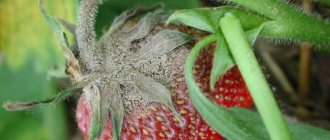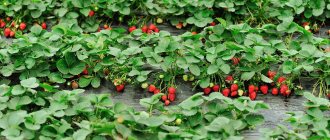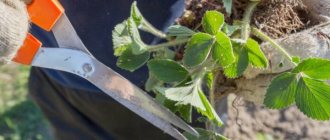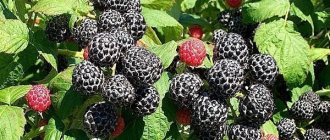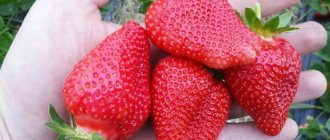The most delicious berry in the garden is strawberries. In addition, it contains nutrients that our body needs. But this product is quite capricious, so you need to try to get a good harvest.
Before and after fruiting, we must feed strawberries with various fertilizers. However, many gardeners neglect to care for berries in the fall before frost. And this procedure is necessary for good development, as well as to increase the period of fruiting and harvest.
We remove leaves from the bushes, loosen and mulch the soil. Today in the article we will look at the nuances of processing this crop, as well as the rules for fertilizing the plant. Such gardening work allows you to nourish the soil and reduce the risk of developing diseases in the future.
Treatment of strawberries in the fall from pests and diseases
Summer berries are susceptible to viral and fungal diseases. It is also constantly destroyed by various pests. Therefore, it requires regular care. In the autumn, it is necessary to carry out treatment.
To prevent the risk of pests in winter, it is recommended to use the following means:
- Metaldehyde helps against slugs. 5 g of the drug will be needed per 1 sq. m.
- Kleschevit and Karbofos allows you to get rid of transparent mites. An ash solution is used for the same purposes.
- If Victoria is damaged by weevils, then use Aktaroy, Intavir or Actellik.
- You can get rid of woodlice manually. We check all the leaves and destroy pests.
Don’t forget to remove dry leaves and weed the beds to remove weeds.
A universal remedy against diseases and harmful insects is the folk method. To do this, we will prepare a solution. Mix 3 tablespoons of sunflower oil, 2 cups of liquid soap, 2 tablespoons of table vinegar and 2 tablespoons of ash. Mix all ingredients in a bucket of clean water.
Using the resulting mixture, we make foliar feeding and pour it under the bushes.
Remontant berries should be sprayed before winter, and regular varieties in September-October, depending on weather conditions.
To protect the plant from low temperatures, we cover it with coniferous branches or special material.
Autumn treatment of strawberries with copper sulfate
This drug is considered a universal remedy that is widely used in the garden. Experienced summer residents always have copper sulfate on hand, as it helps get rid of powdery mildew and other diseases.
To process the berries, you need to stir 3 g of blue stone in a bucket of water. We spray the plant and then cover it so that it does not die in winter.
There is another solution for treating Victoria. In 3 liters of boiled, cooled water, stir 5 g of copper sulfate and 200 g of grated laundry soap. Mix everything thoroughly for several minutes. Pour the liquid into a spray bottle and spray the bushes.
Benefits of Bordeaux mixture
- ✔ Does not cause pathogen resistance to the active substance.
- ✔ Protective period of 14 days or more
- ✔ Used on many crops
- ✔ Low toxicity for bees.
- ✔ Beneficial effect on the plant during copper starvation
- ✔ Easy to prepare
- ✔ Has repellent properties for many insects.
- ✔ Low cost.
It is important to know:
- ✔ Bordeaux mixture does not have a healing or eradicating effect.
- ✔ It has good effectiveness with early spring and autumn treatments.
- ✔ In almost all cases, a 1% solution will be used.
- ✔ Last spraying - 15 days before harvesting.
- ✔ Recommended for use together with adhesives (surfactants). Before use, check the miscibility of the components.
- ✔ Do not process in high humidity or hot weather. This will avoid leaf burns.
- ✔ Bordeaux mixture is not effective against peronosporosis of shag and tobacco, as well as against powdery mildew.
- ✔ Before use, be sure to read the instructions for use.
- ✔ The finished solution of Bordeaux mixture can be stored for no more than a day.
- ✔ It is recommended to use no more than 4 times per season.
In agriculture, 1% and 3% Bordeaux mixture solutions are used. A liquid of 3% concentration is used in early spring for the first spraying of trees and shrubs - during this period the buds have not yet opened, copper will not burn the leaves and ovaries. For some crops, treatment can be carried out in late autumn - this will reduce the infection of plants with diseases in the next season. For a solution of 1% concentration, use it at the moment when the trees and shrubs have already faded, the ovaries and leaves have formed.
Prepare a 3% solution
A 3% solution of Bordeaux mixture is used to treat tree trunks, shrubs and grape vines. Since such a concentration of the solution can cause leaf burns, it must be applied in early spring or late autumn. This will help protect crop plants from fungal diseases. To prepare 3% Bordeaux mixture, dissolve 300 g of copper sulfate in 1-2 liters of hot water. To do this, use glass, enamel or plastic containers, never metal . In another container, dilute 300-400 g of lime in 2-3 liters of cold water. Then bring each solution to a volume of 5 liters by adding cold water. Carefully strain the resulting lime milk through thick gauze or nylon cloth. Pour the copper sulfate solution into it in a thin stream, stirring frequently. The mixture should turn sky blue.
After preparing the solution, it is necessary to check the pH of the liquid. This is necessary in order not to harm the plant, since the resulting solution must have a neutral or slightly alkaline reaction. You can use litmus paper or a nail to determine pH. If, after dipping into the solution, the litmus paper turns blue, the solution is ready for use. If it turns red, add some milk of lime to the solution and test again. If you dip a nail in the solution for 1.5-2 minutes and it turns red, then you need to add a little more lime solution to the liquid. Do this until the metal stops changing color under the influence of copper.
❞ When processing, it is necessary to moisten the plant abundantly and evenly so that the solution flows down the branches and trunk, penetrating into all cracks in the bark, since a large number of pathogenic microorganisms accumulate there. Correctly carried out treatment protects trees and shrubs from diseases and pests for a month.❞
Prepare a 1% solution
To prepare a 1% Bordeaux mixture, take 100 g of copper sulfate and 100-150 g of lime, dissolve the sulfate in 1 liter of hot water, and the lime in 1 liter of cold water (in separate containers). Don't forget that you can't use iron containers! As in the previous case, bring each solution to 5 liters, then strain the milk of lime and add copper sulfate to it. Don't forget to check the solution's pH level.
How to treat strawberries from gray rot without cutting leaves
In the fall, it is recommended to remove all damaged and dry leaves, but if you did not have time to do this, you can still treat the strawberries with special preparations.
The following remedies are suitable in September and October:
- Nitrophen. Apply in late autumn. 150 g of paste should be mixed in 10 liters of heated water. Spray the bushes with the resulting mixture and pour it into the soil. The drug helps fight gray mold, as well as many pests.
- Copper oxychloride. Stir 1 tablespoon of the product in a bucket of warm water. We spray the crop not only in the fall, but also in the spring.
- Folk remedy. In 10 liters of warm water we dilute 500 ml of liquid soap, 3 tablespoons of vegetable oil, 2 tablespoons of wood ash and 2 tablespoons of table vinegar. We process the soil and bushes.
All these solutions help fight diseases that summer berries are susceptible to.
Preparations “2 in 1” and “3 in 1”
This category includes recipes that can make our work easier when processing strawberries, allowing you to do just one spray for several problems:
- Thiovit Jet. The bag contains a mixture of fungicide and acaricide, that is, the drug is effective against fungal diseases and mites, it will not affect insects. The contents of one package (15 g) are diluted in 5 liters of water. Effective in a narrow temperature range of +20… +28 °C.
Tiovit Jet - one remedy for both diseases and ticks
- Strawberry rescuer “3 in 1”. The set contains an insectoacaricide, a fungicide and a growth stimulator. All three drugs are in different ampoules, but are compatible. They are poured one by one into 10 liters of water and mixed. With one treatment you get rid of diseases and all kinds of pests. It must be processed during the growing season, that is, at temperatures above +10... +15 °C, the mixture is also effective at elevated temperatures.
Strawberry Rescuer is three ampoules with compatible drugs
- Homemade mixture of insectoacaricide Karbafos and fungicide Skora. The drugs are sold separately, but gardeners have already tested them for compatibility and recommend them for use. 60 g of Karbofos and 2 ml of Skor are dissolved in 10 liters of water. It is necessary to process at temperatures above +15 °C and below +25 °C.
Video: processing strawberries in autumn with the “3 in 1” Rescuer
How to feed berries after planting and replanting
If you planted strawberries in the autumn, then they must be fertilized so that the soil contains the necessary microelements. It is important to note that fertilizing allows you to increase productivity by at least 30%.
Experienced gardeners advise using organic fertilizers. Let's look at the most popular types of feeding.
Chicken droppings
To make an effective means for feeding the soil, you need to dilute 1 kg of litter in 10 liters of water. Infuse the solution for 2 days, then filter and pour under the root.
Mullein
Mix the dry material in water in a ratio of 1:10. After a day, add wood ash and water the beds. We do not use this mixture as a foliar feeding.
Ash
It is a universal fertilizer that replenishes the soil with calcium. Sprinkle each square meter with 150 g of wood ash. It can also be used in liquid form; to do this, dilute a glass of the material in a bucket of water. Pour 500 ml under each bush.
After feeding, the berries must be watered.
Also watch a video with instructions for caring for strawberries in the autumn:
Of course, every gardener has his own secrets of caring for strawberries, taking into account his own observations. You also need to take into account the climatic conditions of certain regions and the current year.
There is a lot of work in the garden in the fall, even if the harvest has already been harvested. It is necessary to remove fallen leaves and take care of the condition of each perennial plant so that they can calmly go into a dormant stage. Treating strawberries in the fall against pests and diseases is a very important procedure. If you do not neglect it, next spring it will be able to produce a healthy, full-fledged harvest.
Pest Control
Pests need to be gotten rid of
In addition to diseases, strawberries have many harmful insects that destroy leaves, stems, flowers and berries.
| Powdery mildew | Foundationazole, copper sulfate solution, Bordeaux mixture, Topaz | The chemical is classified as a contact pesticide. Dosage - 10 g per bucket of water (per area of 1 m²). |
| Anthracnose (black spot) | At an early stage, Ridomil Gold, Quadris and Metaxil are used. | |
| Two treatments of leaves, stems and soil with an interval of 7 days are sufficient. | ||
| White, brown and angular spotting | Fungicides (copper sulfate solution or Bordeaux mixture) | Spraying is carried out four times a year - before the budding period, after picking berries, in mid-August and in the first half of September |
| Red spot | Iodine | Treat three times per season - at the beginning of spring, before flowering and after fruiting. |
| Black rot | Ordan | You need to treat the above-ground part and the soil under the bushes. |
| Root rot | No treatment | The bushes are dug up and burned. The soil is spilled with a solution of copper sulfate or potassium permanganate, then dug up. |
| Viral diseases (mosaic, mottling, berry growth, wrinkling, marginal yellowing of leaves) | Diseases that are difficult to treat, spread quickly, and are easier to prevent | To avoid infection, you should avoid dense plantings, take strong seedlings, regularly loosen row spacing, and remove harmful vegetation |
| Late blight | Fundazol (0.2%) | Twice autumn treatment of the bushes and the soil under them is necessary. |
| Fusarium | Potassium oxide | Embed into the soil under the bushes during loosening. Additionally mulch with vinyl film. |
| Greening of petals | Karbofos, garlic infusion, ash-soap solution | You need to process twice with an interval of 7 days. |
| Verticillium wilt | Treatment of the disease is impossible, but the biological product Gumat K is used for prevention | Before planting, the root system of the seedlings is dipped in the solution. |
| Chlorosis | inkstone | Spray the root zone and leaves of plants. |
| Name | What to process | Rules and schemes |
| Whitefly | Aktellik, Confidor, Rovikurt, Pegasus | Use no more than four times per season, the amount of the drug according to the instructions |
| Weevil | Karbofos | The treatment is carried out twice - before flowering and after harvesting. For prevention, additionally spray with red pepper tincture (½ tsp per 5 liters of water). |
They also use folk remedies - they spill the bushes with hot water, treat them with a solution of mustard and laundry soap, and plant aromatic plants - onions, garlic - in the rows
Autumn processing requires dry, windless and cloudy weather.
After harvesting, processing is carried out.
Then, repellent crops are laid between the bushes - anise, mint or tansy.
For high-quality protection of the strawberry plantation, you can use urea (1 tablespoon of the substance will be dissolved in 10 liters of water). Spray the bushes and the soil under them a month before the onset of cold weather.
There is a lot of work in the garden in the fall, even if the harvest has already been harvested. It is necessary to remove fallen leaves and take care of the condition of each perennial plant so that they can calmly go into a dormant stage. Treating strawberries in the fall against pests and diseases is a very important procedure. If you do not neglect it, next spring it will be able to produce a healthy, full-fledged harvest.
Why process strawberries in the fall?
Healthy strawberries produce a bountiful harvest, high-quality berries, ready for processing or sale. But even if the bushes were not sick in spring and summer, they can be affected in the fall, because pests hide at this time for the winter, and strawberry bushes are quite a suitable place for them. At the same time, strong winds and frequent rains are favorable weather conditions for the proliferation of fungal and viral diseases.
Photo of strawberry processing in autumn
Autumn processing of strawberries is aimed at destroying all pests that hide in the axils of strawberry leaves, near the root system, as well as diseases that have already settled on them.
When is the treatment carried out?
Strawberries are processed in the fall after the last harvest has been harvested. If you grow simple strawberries, you can do it at the end of September. But if the strawberries are remontant, then the processing is postponed until October-November, when the last berries are collected.
Before processing, it is necessary to remove the bed. All old, dry leaves, in which pests and diseases can hide, are removed from the bushes, the rows are thoroughly cleaned of weeds, fallen leaves - a hotbed for the spread of fungal spores. You can also dig up the row spacing so that during treatment the drug can easily penetrate into the soil and not just get on the leaves of the plants.
Strawberry pests
Pests that often plague strawberries include earthen and spider mites, aphids, strawberry-raspberry weevils, slugs, and snails. Bushes can also be affected by nematodes, small black mowers, alfalfa mowers, and strawberry sawflies.
Pests of strawberry leaves
Processing strawberries in the fall involves the use of insecticides against pests. Since it is carried out after the harvest, you can use quite strong drugs that will certainly help get rid of annoying insects.
Let's sum it up
Autumn treatments of strawberries against diseases and harmful insects are a mandatory procedure for pre-winter preparation of the berry crop. They help protect plants against cold weather and create favorable growing conditions for the next season.
It is possible to treat the bushes with insecticidal and fungicidal preparations, as well as solutions prepared according to folk recipes. The beds should be sprayed before the onset of frost after harvesting at the recommended time, taking into account the regional characteristics of cultivation.
Snails and slugs
Snails and slugs are not easy to remove. But if you systematically fight them, they will definitely leave the area. To begin with, you should use the mechanical method. They are simply collected by hand as they appear. It is better to do this in cool weather, when they crawl out of their shelters.
The slug not only spoils the leaves, but also eats strawberries
When mechanical cleaning does not produce results, insecticides can be used. During the autumn processing of strawberries, the insecticide “Metaldehyde” is used. It copes well with snails and slugs. Plants are not sprayed with it, but granules are simply scattered around the bushes where these pests most often appear.
Treating strawberries against aphids and mites
If strawberry or spider mites often appear on your site, you should definitely treat the strawberries with a remedy against them in the fall. For example, “Aktellik”, “Karbofos”, “Aktofit” or “Fitoferm”. True, "Actofit" is usually used when the plant is growing - in the spring, and after harvesting, "Fitoverm", "Aktellik" and "Karbofos" are considered more effective. You can also use a solution of Bordeaux mixture (3-4%), potassium permanganate or copper sulfate (2-3%).
Aphids on strawberries
These same products help effectively fight aphids on strawberries. Treatment of strawberries in the fall is sometimes carried out after the old leaves have been cut off, some gardeners cut off young leaves, that is, aphids may not be visible, but if they were there in the summer, even in small numbers, it won’t hurt to treat them.
Among the folk remedies for ticks and other pests, a solution of 10 liters of water, 2 tablespoons of liquid soap, 3 tablespoons of vegetable oil, 2 tablespoons of vinegar and 2 tablespoons of ash will help. All this is mixed well and used for spraying. To prevent aphids, you can also simply sprinkle the top of the bushes with wood ash ground into dust.
Dates
Gardeners usually face two problems: what preparations and fertilizers to use for spraying and feeding the bushes and what is the time frame for processing strawberries. You need to know exactly when to carry out the procedure so that it is as effective as possible. If you are a couple of weeks late, the risk of crop loss increases several times.
in spring
The very first treatment of strawberries after winter is carried out as soon as the snow melts and the temperature reaches above zero. What to use:
- as a top dressing in early spring - manure, humus, wood ash solution or yeast, nitrogen-containing fertilizers (to stimulate growth). It is used in areas with a mild climate, where there are no prolonged and severe return frosts;
- against fungi, the spores of which could overwinter in the soil and microcracks in the trunks - Bordeaux mixture;
- from insects whose larvae tolerate winter well and become active in the spring - Karbofos, Aktelik and other insecticides.
Early spring processing of strawberries is one of the most important. Fertilizers help bushes recover after winter and fully start sap flow. Fungicides and insecticides prevent epidemics, because larvae and fungal spores could be hiding in the soil or microdamage to shoots since last autumn.
However, this is not the end of spring processing. There is no need to fertilize with fertilizers—one time is enough. But spraying with fungicidal and insecticidal solutions is necessary, and more than once:
- the first time - before budding, when flower stalks begin to emerge;
- the second time - during full budding;
- the third time - during flowering.
In summer
Active fruiting begins in June. Therefore, it is advisable not to apply any chemical fertilizers. Fungicides and insecticides are also temporarily banned. Otherwise, the berries will absorb toxins and become poisonous. They can be eaten only 3 weeks after spraying, but they are unlikely to last that long on the bushes.
What to do if it was during fruiting that the strawberry became a victim of a fungal infection or an invasion of insect pests? In this case, there are only 2 options. The first is to treat it with “chemicals” and never taste this year’s harvest. The second is to treat with folk remedies, but they are not always effective.
But after harvesting, repeated treatment with insecticidal and fungicidal solutions is allowed, regardless of whether the bushes are sick or not. Use complex mineral fertilizers as top dressing. All the strength of the plant has gone into the berries, and at this stage it may wither. Therefore, support is required.
in autumn
In autumn, feeding and processing strawberries is divided into 2 stages. The first one is optional. It is held in September for those bushes that were sick in the summer or survived an insect invasion. Repeated spraying with fungicides and insecticides will completely destroy the remaining larvae and spores.
The second stage is mandatory. Its purpose is to prepare the bushes for the winter to withstand low temperatures. Feeding with mineral complex fertilizers can help with this.
The seasonal calendar of treatments and fertilizing will help you navigate the timing and preparations, in which everything is described in stages:
If you plant seedlings in film greenhouses, then the calendar of preventive treatments and fertilizing will look like this:
Treatment of strawberries in the fall from weevils and other beetles
There are two types of weevils that harm strawberries: earthy and gray root. If they are not dealt with, they can quickly spread throughout the area and destroy strawberry plantings. Autumn processing of strawberries allows you to cope with beetle larvae, which live on the roots and feed on their juices, and adults, which can hide in hard-to-reach places of the bush.
Photo of beetles on strawberries
If we talk about strong chemical preparations, Actellik, Intavir, and Aktara are good for removing weevils. Most often they are used when flower stalks or buds appear, but the products are also effective in the fall. And what’s more, they help not only against weevils, but also against a number of other pests, including sawflies, mowers, and ticks.
Autumn processing of strawberries is an important part of plant care. If you carry it out year after year, there will be no pests or diseases on the bushes. The plant will be able to fully develop and produce abundant harvests.
Capricious and whimsical strawberries are susceptible to various fungal diseases and are often affected by harmful insects. Timely and competently carried out autumn preventive measures will allow you to avoid unpleasant problems next season.
Benefits and possible harm
Bordeaux solution is a mixture of water, copper sulfate and slaked lime. The ratio of these components varies depending on what concentration the finished liquid should have. Using this product to process strawberries has its advantages and disadvantages.
- Ready-made Bordeaux mixture has the following beneficial properties:
- copper sulfate is a very effective antiseptic that destroys harmful fungus;
- lime cauterizes the source of the disease on the leaf and prevents the spread of infection;
- the product can be used to treat many diseases of strawberries - black and gray rot, anthracnose, septoria, spotting, powdery mildew, leaf rust;
- the pest insect will not be able to lay eggs on the treated strawberry bush, which will avoid the appearance of larvae;
- contains calcium ions that reduce high levels of soil acidity;
- does not penetrate into the pulp of the berries - the prepared solution remains only on the surface of the fruit, performing its protective function;
- the product stays on the plant for up to 1 month and is not washed off by rain, providing long-lasting protection against diseases.
Read also: Delicious things to do with avocados
- Before using Bordeaux mixture to process strawberries, you must take into account the harmful properties of this mixture:
- the product has a negative effect on bees - in the first few hours after treatment, it is advisable to limit the access of these insects to the beds;
- the solution is toxic to humans and causes severe irritation of the mucous membranes, so you need to use a respirator and rubber gloves to process strawberries;
- over time, the drug accumulates in the soil and can lead to premature falling of leaves and ovaries;
- if the dosage and rules of use are violated, the substance can cause chemical burns to the leaves;
- causes serious food poisoning in humans - strawberries should not be eaten in the first 2 weeks after treatment.
Pest repellents
For preventive spraying of strawberries in the fall against insect pests, the following preparations are used:
- Chemical:
- Karbofos (30 g per 10 l) - against strawberry and spider mites;
Many gardeners still prefer time-tested karbofos
Alatar can be used to destroy white beetles and leaf rollers, ticks and weevils, aphids and the Colorado potato beetle
Actellik is an insecticide that helps get rid of pests such as codling moths, mites, aphids, sawflies, moths, thrips, false scale insects, whiteflies, scale insects
Insecticide Fufanon-nova is a contact-intestinal preparation for controlling pests of fruit, berries, vegetables and ornamental crops
The use of Inta-Vir makes it possible to quickly and effectively destroy almost any insect pest
The insecticidal drug Aktara is popular among plant growers due to its speed, strength of action and wide range of targets for elimination.
Due to the rapid decomposition of the product under the influence of light, it is necessary to spray plants at dusk
The biological insecticide Verticillin contains live cells of the parasitic fungus Verticillium lecanii, which germinate into the body cavity of insects and, releasing toxins, cause the death of pests
Actofit is a drug based on avermectins, natural highly specific neurotoxins, which, penetrating into the body of insects through contact or intestinal routes, cause irreversible damage to the nervous system
Leaves and shoots can be used to prepare a decoction.
The smell of garlic repels aphids
Dandelion infusion inhibits the vital activity of pathogenic microorganisms, in particular the fungus that causes gray rot, and repels many pests, including aphids, ants, copperheads and various mites
Bioinsecticides are most effective at air temperatures not lower than +16…+18 °C. These drugs have a targeted effect on insects, and therefore are considered practically safe for humans and pets.
Video: fighting the strawberry mite after pruning strawberries
Remedies against diseases
For preventive autumn spraying against diseases, the following products are used:
- Chemical:
- Bordeaux mixture: 1% - from spotting, 2–4% - from gray rot;
Bordeaux mixture is one of the most powerful remedies in the fight against fungal or bacterial diseases
The drug Topaz instantly attacks fungal spores and prevents it from developing further.
Fundazol is a broad-spectrum fungicide (antifungal agent) for plant protection
Strawberry beds are sprayed with copper oxychloride against rot and spotting.
When growing garden strawberries, the drug is useful throughout the entire summer season, from early spring to late autumn.
Alirin-B breakdown products do not accumulate either in the plant itself or in its fruits
Trichodermine for strawberries and raspberries is used to destroy fruit and gray rot, combat late blight, cytosporosis, verticillium
Hay infusion is traditionally used against powdery mildew on strawberries
Ash is sprinkled on all the leaves, stems and center of the strawberry bush.
Spraying with mustard powder infusion will help stop the development of gray rot and powdery mildew on strawberries.
A solution of copper sulfate (30 g per 10 liters of water) protects strawberry bushes from attack by pests and fungal pathologies. Regular iodine (5 drops per bucket) will repel weevils and ticks, and also prevent the appearance of gray rot.
At the end of the growing season, it is imperative to treat strawberries against pests and diseases.
A neighbor shared with me a universal recipe for processing garden strawberries, which is effective against both pests and most diseases. The working emulsion is prepared from:
- wood ash - 2 tbsp. l.;
- boiled vegetable oil - 3 tbsp. l.;
- table vinegar - 2 tbsp. l.;
- liquid soap - 2 tbsp. l.; warm water - 10 l.
Video: hot shower for strawberries
Pest extermination
You can prepare the treatment solution yourself
Preventive and therapeutic treatments against harmful insects are carried out with insecticidal preparations and solutions prepared according to folk recipes.
Whitefly
A butterfly with white waxy wings settles on the lower tier of leaves and feeds on plant juices.
Means for fighting:
- Actellik - 20 ml diluted in 2 liters of water. Treatments are repeated at intervals of 1 week (consumption 1.5 liters per 10 m²).
- Intravir - 1 tablet per 1 liter of water. The resulting concentrate is brought to a volume of 10 liters and the bushes are treated.
Ticks
Lead to stunted plant growth.
Used to fight:
- Karbofos at a concentration of 0.3% - 30 g of the active substance is diluted in 10 liters of water. Use for spraying once a season.
- Fitoverma. The working liquid for treatment is made from 1 ampoule per 1 liter of water.
- Copper sulfate - 300 g per 10 l. Used for spraying.
- Bordeaux mixture - for treating bushes, 400 g are diluted in 10 liters of water.
- Tomato tops - 1 kg of vegetation (leaves and shoots) is poured into 10 liters of boiling water, kept for 5 hours and then boiled for 2 hours. The beds are treated several times with an interval of 1 week.
Weevil
The black beetle causes damage to the inflorescences. It settles in fruiting buds and feeds on plant juices.
Suitable for fighting:
- Aktara - 4 g per 1 liter of water.
- Intravir - 1 tablet. diluted in 1 liter of water, the volume of working fluid is adjusted to 10 liters.
- Wormwood - 1 kg of herbs is boiled in 4 liters of water for 10 minutes, filtered, the volume of the finished mixture is increased to 7-8 liters, 50 g of laundry soap is added and the plantings are sprayed against weevils.
Nematode
Small white worms provoke swelling on the vegetative parts and cause deformation of the petioles.
Strawberry bushes affected by the nematode are dug up and burned.
Caryopsis beetle and strawberry leaf roller
The beetles feast on strawberry seeds, eating the pulp of the berries. The leaf roller entangles the plant in a web and feeds on the green vegetative parts.
Used to fight:
- Potassium permanganate is diluted in hot water in a concentration to a bright crimson color, the beds with strawberries are watered and sprayed once at a rate of 10 liters for every 10 m² of beds.
- 200 g of onion peels are poured into 10 liters of hot water, left for 5 days, and sprayed on the plantings.
- 200 g of chopped garlic per 10 liters of water. Leave for 3-4 hours and treat the plants up to 3 times in the fall with an interval of 10 days.
Video: autumn treatment of strawberry beds from pests and diseases
Strawberry plantations need to be treated against pests and diseases not only in the spring. According to most gardeners, autumn preventive measures have a much greater effect compared to spring treatments and can significantly reduce damage from fungal pathologies, as well as from attacks by harmful insects during the next growing season.
- Author: Maria Sukhorukikh
Rate this article:
- 5
- 4
- 3
- 2
- 1
(0 votes, average: 0 out of 5)
Share with your friends!
Timing for spring spraying of strawberry beds
In order for preventive spring treatments of strawberries to be as effective as possible, it is necessary to adhere to the optimal timing for carrying out these procedures.
Stages of strawberry processing in spring:
- The first measures to combat possible diseases and pests are carried out immediately after the snow cover melts and the strawberry plantings are freed from winter shelter. Specific dates are determined by local climate and weather conditions. In the warm southern regions, strawberries wake up already at the beginning of March, in the northern regions this happens a little later (at the end of March or beginning of April).
- The bushes are sprayed again immediately before the crop blooms. In the south, strawberry bushes begin to bloom in late April or early May; in cold climates, flowering occurs no earlier than late May or early June. Much depends on the variety of strawberries.
They try to carry out the first spring preventive treatment of strawberry plantations as early as possible
All spraying is carried out only on a windless and dry day. Early morning or just after sunset is best for this.
We always plant winter garlic between the strawberry bushes in the fall. Its pungent aroma discourages weevils from settling on plantations. There is no need to bother with decoctions and sprays. Onions planted next to strawberries have a similar effect. Many summer residents plant calendula along their strawberry beds, which repels nematodes.
